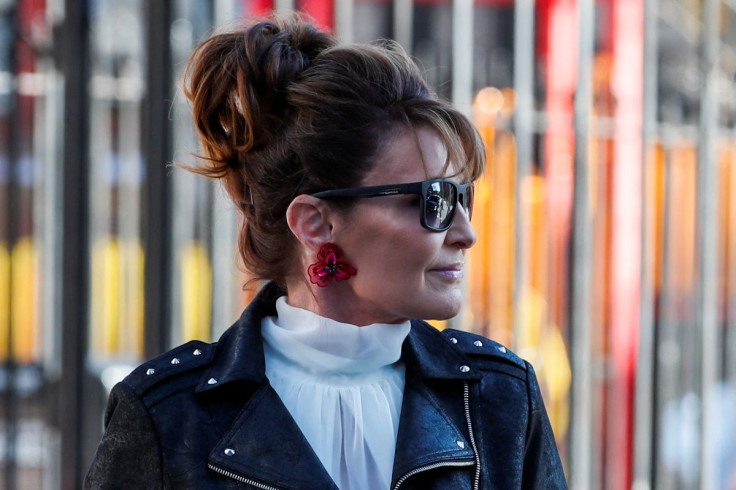Analysis-Sarah Palin Defamation Case A Long Shot For U.S. Supreme Court -experts

Sarah Palin faces a narrow path ahead if she wants to use her defamation case against the New York Times as a vehicle to challenge broad U.S. legal protections for news organizations, media lawyers said.
After losing a jury trial on Tuesday, the prominent Republican is likely to appeal and ultimately to ask the Supreme Court to revisit a landmark ruling called New York Times v. Sullivan, experts said.
Palin said this month that she would consider such a challenge, but has yet to disclose her planned strategy.
The 1964 decision, which made it difficult for public figures like Palin to win defamation cases, has come under increasing scrutiny in recent years and looks more vulnerable to reversal than at any time in the past.
U.S. protections against defamation challenges are generally stronger than they are in other countries, and some critics have said this framework provides too much license for error, especially in the internet age. Defenders of the standard say it has been essential to safeguarding a free press.
But even if the high court is interested in reconsidering the Sullivan case -- which is far from clear -- Palin's lawsuit may not present the ideal opportunity for doing so, in part because both a judge and jury have now forcefully ruled against her, media law experts said.
"This case is not the right vehicle for the Supreme Court to revisit Sullivan," said Gautam Hans, a law professor at Vanderbilt University. "I think this is just a really uphill road for the Palin side."
Because the Times acknowledged errors in the editorial about Palin, her case has always hinged on whether the newspaper acted with "actual malice," the legal standard set forth in the Sullivan case for defamation lawsuits brought by public figures. It requires proof by "clear and convincing evidence" that a publisher either knowingly disseminated false information or showed a reckless disregard for the truth.
A nine-person federal jury in Manhattan unanimously concluded on Tuesday that the New York Times did not defame Palin, a former vice presidential candidate, in a 2017 editorial that incorrectly linked her rhetoric to a mass shooting years earlier. U.S. District Judge Jed Rakoff announced on Monday, outside the presence of the jury, that he would rule for the Times regardless of what the jury decided.
"The fact that the judge and jury found no actual malice may be a cautionary light for her (Palin's) lawyers about whether to take this case further," said David Logan, a Roger Williams University law professor. "Now the odds look a bit bleaker."
NEXT STEPS
The next stop for the case would be the 2nd U.S. Circuit Court of Appeals. But appeals courts are reluctant to second-guess determinations reached by jurors, since they are the ones who hear testimony firsthand and make credibility judgments, said Ryan Cummings, a media lawyer at Hodgson Russ.
If Palin does appeal and the intermediate court rules against her, Palin could then seek review by the high court.
Two Supreme Court justices, conservatives Clarence Thomas and Neil Gorsuch, made clear in an unrelated case last year they want to revisit the media-friendly standard. Four justices are needed to hear a case, and only a majority of the nine-member court can make new law.
In their dissenting opinions, Thomas and Gorsuch said the "actual malice" standard appears outdated and, in the internet age, allows falsehoods to spread rapidly with little accountability.
"Not only has the doctrine evolved into a subsidy for published falsehoods on a scale no one could have foreseen, it has come to leave far more people without redress than anyone could have predicted," Gorsuch wrote.
It is unclear whether Justices Brett Kavanaugh and Amy Coney Barrett, relative newcomers appointed by former President Donald Trump, are eager to revisit the "actual malice" standard, said Hans, the Vanderbilt law professor.
Defamation cases rarely make it to trial, so Kavanaugh and Barrett did not weigh in on the Sullivan case when they were judges on lower courts, Hans said.
Even if justices besides Thomas and Gorsuch are eager to revisit the actual malice framework, the Palin case would also be an unlikely candidate for review because it involves a New York state law, said Benjamin Zipursky, a Fordham University law professor.
In 2020, New York's state legislature passed a law codifying the actual malice standard. Rakoff ruled that law applied to her case. That means Palin would need to show actual malice even if New York Times v. Sullivan were overruled.
The Supreme Court does not generally take cases that rest on state law or whose outcome would not be determined by the high court's ruling, Zipursky said.
Hans said there is another case that could be used to challenge New York Times v. Sullivan, involving a Florida megachurch that says a nonprofit falsely labeled it a hate group. In November, the church, Coral Ridge Ministries Media Inc., asked the Supreme Court to review its case after an appeals court upheld a lower court's dismissal of its lawsuit. Unlike New York, Florida does not have a statute that independently makes "actual malice" the standard in that state.
"It could be that case is more appealing," Hans said.
© Copyright Thomson Reuters 2024. All rights reserved.





















